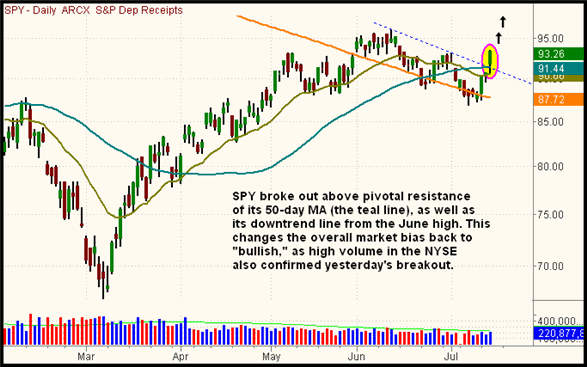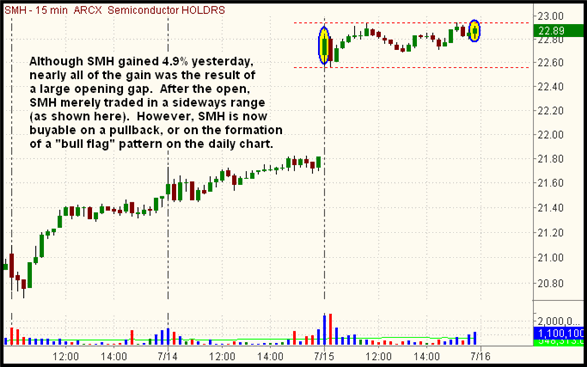|
The Wagner Daily ETF Report For July 16
Sparked by a better-than-expected earnings report from Intel after Tuesday's close, stocks rushed higher out of the starting gate yesterday morning, and never looked back. Driven by strong volume across the board, the major indices trended steadily north throughout the entire session, before closing at their best levels of the day. The Nasdaq Composite jumped 3.5%, the Dow Jones Industrial Average 3.1%, and the S&P 500 3.0%. The small-cap Russell 2000 and S&P Midcap 400 indices climbed 3.8% and 3.1% respectively.
Total volume in the NYSE soared 40% above the previous day's level, while volume in the Nasdaq similarly swelled 37%. In both exchanges, turnover moved back above 50-day average levels, clearly indicating strong demand amongst mutual funds, hedge funds, pension funds, and other institutions. Since more than half of the stock market's average daily volume is the result of institutional trading, rally attempts are usually short-lived if not backed by institutional accumulation. But with all the major indices gaining at least 3%, and on sharply higher volume, yesterday's rather impressive session was undeniably an "accumulation day." Overly bullish market internals confirmed the sudden change of sentiment as well. In the NYSE, advancing volume destroyed declining volume by a whopping margin of nearly 23 to 1. The Nasdaq adv/dec volume ratio was positive by 15 to 1. These ratios indicate the buying was very broad-based, spreading to practically every industry sector.
In the July 14 issue of The Wagner Daily, we discussed and illustrated an important, pivotal level of technical resistance in the S&P 500, using the S&P 500 SPDR (SPY) as a proxy. Specifically, that resistance was formed by the convergence of the 50-day moving average and month-long downtrend line of SPY, which began with the June high. Of that area of resistance, we said, "All eyes should be focused on this convergence point, around the $91.25 to $91.50 area (910 to 915 in the S&P 500), as it is a key area of resistance that could determine the outcome of the market's short-term direction." In case you didn't notice, yesterday's rally shattered that area of technical resistance. Moreover, the rally also destroyed the "head and shoulders" patterns in the S&P and Dow, which were previously lending a bearish bias to the intermediate-term trend of the broad market. Below, we've annotated the breakout in SPY:

In yesterday's commentary, we pointed out the relative strength and potential breakout in the Semiconductor HOLDR (SMH). Not surprisingly, the 4.4% gain in the Semiconductor Index ($SOX) that followed caused SMH to gap above that major area of horizontal price resistance, closing at a nine-month high in the process. But because SMH was already trading 4% higher on the open, we passed on buying the breakout. We didn't miss much so far, as SMH traded in a tight, sideways range throughout the day, then finished only slightly above its opening price. This is illustrated on the 15-minute intraday chart of SMH below:

Although we did not buy SMH yesterday, this does not mean we're forgetting about the semiconductor sector and moving on. Rather, we will now wait for either a pullback to near the breakout level or the formation of a "bull flag" pattern, whichever comes first. Buying on a retracement, or at least after a few days of price consolidation, is a good strategy for entering bullish breakouts that initially fail to provide ideal buying opportunities because of large opening gaps. If/when we spot an entry into SMH that provides a positive reward/risk ratio, we'll promptly send a detailed Intraday Trade Alert to regular subscribers.
Yesterday's stock market strength spurred the rotation of funds out of fixed-income, and into equities. As such, our long position in iShares 20+ year T-bond (TLT) hit its stop price, after failing to hold its recent breakout attempt. The good news, however, is our long position in iPath India Index (INP) motored 6% higher yesterday, giving us an unrealized gain of more than 3 points on the trade, which we bought on the July 8 "undercut" of its 50-day moving average. Now that it has broken out above its five-week downtrend line, and has reclaimed its 20 and 50-day moving averages, INP should be on its way to retesting its June 2009 high in the near-term.
Assuming yesterday's broad-based breakout was legitimate, and we have no reason to assume it wasn't, the market will soon start presenting us with new ETF buying opportunities. At this point, we're most interested in buying ETFs that show relative strength by breaking out above their June highs, or similar levels of horizontal price resistance, ahead of the major indices. When they do, we'll either be looking to buy the breakout, or the first pullback that follows the breakout, depending on the pattern. If yesterday's rally was the start of a new, sustainable uptrend, there will be plenty of time to profit on the long side, so we're not concerned that we didn't buy on the very first day the market showed real strength. Furthermore, we've already locked in sizeable gains in several "short ETFs" this month, most of which we sold near their highs last week. "Trading what we see, not what we think" enables us to change our bias back to the long side of the market, at least for now.
Open ETF positions:
Long - INP
Short - (none)
Deron Wagner is the Founder and Head Trader of both Morpheus Capital LP, a U.S. hedge fund, and MorpheusTrading.com, a trader education firm.
|